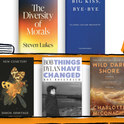Six months ago, I found myself in bed with a 17th-century duchess. It was a rather crowded night—we were joined by her other titles and personae: a most esteemed “princess”, an “empress” and an “authoress of an entire world”—but I was less shocked than I might have been. Margaret Cavendish, the first duchess of Newcastle, the pioneering feminist author, philosopher, poet and scientist, had been my constant companion while I was brushing my teeth, standing on the tube, or (more explicably) sitting in the library for the best part of a year, during which I had been writing her biography.
The morning I woke up and realised I had spent the night with Cavendish was in a week of copy-edits: of changing individual words, moving semicolons and questioning the sense of every sentence I had written. Something about the process—one of literary stitch-ripping and subsequent repair—had brought her into my dreams again, months after I had written my way to the end of her life.
Over the course of the book, I had dreamed of Cavendish multiple times. She was never a spectral, ghostly presence, nor a particularly embodied one either. There were, sadly, no outrageous dresses in my room, or dazzlingly glamorous coaches outside my window. She had appeared to me mostly conversationally. Speaking with remarkable grace to a young upstart biographer— no duchess, empress or authoress of an entire world—she talked me through chapter structures, suggested lines of her work to quote, and, on one occasion, told me which words of hers should end the book.
These conversations didn’t happen every week. But they were regular enough that, despite their oddness, they went by almost unremarked. They were little more than an anecdote to tell friends when they asked me how the process was going, or a joke to tell my therapist, and my parents, when they worried how I was dealing with the pressure of producing a book (“I’m going crazy, but in an amusingly harmless literary way, I promise!”). I was never sure that anyone believed I was telling the truth.
There is, after all, something embarrassing about a biographer dreaming of her subject. It brings to mind the age-old accusation that the writer has “fallen in love” with her subject, with the corpse she’s reconstructing out of paper and ink. She’s no longer a neutral referee, marshalling the facts and material of a long-dead life, but instead is blushing at every letter she reads and, with the dedication of the besotted, trying to make the object of her crush appear in the best light possible. It’s an accusation that is meant to make the product—the biography—somehow flawed. Too unreliable; too emotional; too engaged with an act of distasteful literary necrophilia.
At her best, a compromised biographer could write flights of fancy in the way that, for instance, Peter Ackyroyd has (the novelist and biographer included one of his dreams in his experimental 1990 biography of Charles Dickens). At her worst, she could elide crucial facts in favour of reconstructing her subject as she would prefer to imagine them.
This is the point where I should say, “I am not crazy. I do not actually think Margaret Cavendish—a woman who has been dead for 350 years and lies in a tomb in Westminster Abbey—talked to me in my dreams.” I wish I could, without crossing my fingers behind my back. It would make me seem far more of a serious historian and a diligent, respectable writer.
Rationally, of course, I know there’s an explanation for my dreams: the subconscious works in weird ways and, in the face of a social life sacrificed to the British Library’s manuscripts room, my brain had decided to give me a little conversation, albeit that of a dormant kind.
And I have to admit there was—and is—a dangerous side to my imagination. In my waking moments, my vision of Cavendish became unmoored from her age; a figure who never, and could never have, existed. I started keeping long lists of her likes and dislikes in the notes app on my phone. (Likes: Florence and the Machine; “coquettecore” fashion all the rage on TikTok; Lana Del Rey; green gel pens; Mitski; Iris Murdoch novels. Dislikes: baggy cargo trousers; historically faithful productions of Ben Jonson’s plays; politicians quoting Latin). It is a credit to my publisher Neil Belton that, prior to this article, none of these ahistorical musings had made it into print.
Part of me cannot accept that my dreams and imaginings were just the products of an over-read subconscious
There’s an element of ownership here, in both my dreams and imaginings: with all the idiosyncrasies I conjured up for her, my Cavendish became unique, and mine alone. Nobody else has spent hours imagining the 17th-century author listening to Nina Simone on vinyl, or screaming along at the top of her voice to Lana Del Rey’s lyrics (“goddamn man-child, you fucked me so good I almost said, ‘I love you’”). It’s a 21st-century, more deranged version of Hermione Lee’s admission that she felt grief after finishing her biography of Virginia Woolf: “I felt she had been mine,” said Lee. (Obviously I don’t claim to be in the same league as Lee’s titanic work.)
Beyond my own love affair with my imagined Cavendish, these attributes I gave her in my mind had a more sinister impulse, one I tried to fight throughout the book. That is, the temptation to make a historical character—a woman, in particular—“relevant”; a figure who could be reduced to a slogan on the side of a tote bag. I believe, strongly, in preserving Cavendish’s historical contradictions: her moments of extreme radicalism (she wrote with shocking prescience on issues of women’s place in society) must be taken alongside her conservatism (she was a fierce Royalist; a believer in the “great chain of being”; and, among other things, a delightful snob). Did my imagined Cavendish—with a perfectly curated playlist in her AirPods and red-heeled Mary Jane shoes—still have these contradictions?
But, even with these caveats, a part of me cannot accept that my dreams and imaginings were just the products of an over-read subconscious. In The Blazing World—Cavendish’s brilliant, bizarre, protean early work of science fiction—she inserts herself into the work. The “Empress” (herself a veiled version of the author) wants a scribe for her mystical “Cabbala”. “The Duchess of Newcastle”—with her “sense and reason”—seems the most natural choice, and her soul is summoned from Earth to meet the Empress. In a moment of dizzyingly wonderful prose, the two travel through different worlds in winding, endless conversation and have steamy spiritual sex, which Cavendish assures herself does not count as cheating on her husband because it happened when they were divorced from their bodies and “immaterial” in another realm. It only happened in a dream, if you will.
In my more bizarre, self-indulgent moments, I let myself think the same happened to me: Cavendish and I met in a different world and we did have conversations about everything from feminist philosophy to the vagaries of publishing. Only, the dream-world leaves no traces; no proof to convince anyone other than me.
Does all this make my biography less reliable or less trustworthy? I very much hope not (and, I can assure any would-be reader that all facts came from archives and printed words, not Cavendish’s nocturnal whisperings). But biography is, after all, an attempt to capture a life. And, just for a fleeting moment, my sleeping mind had access to another.













